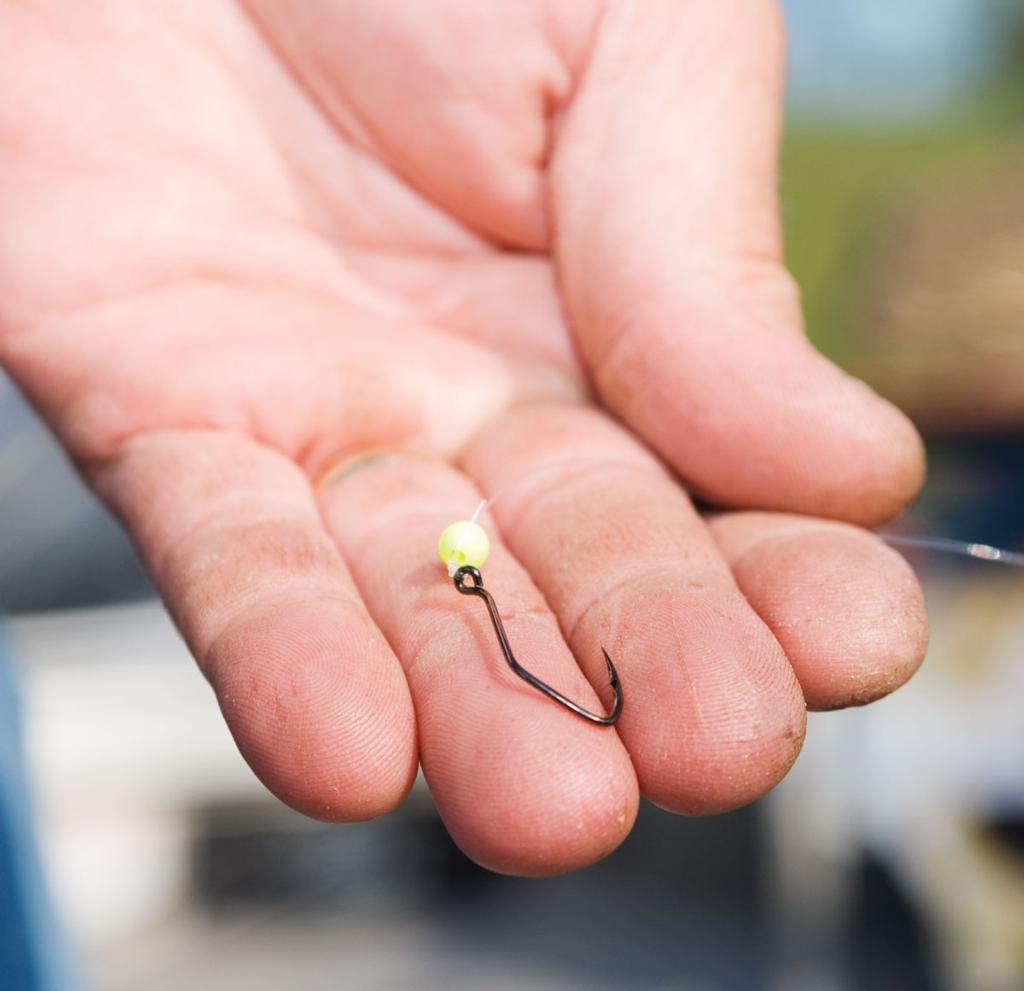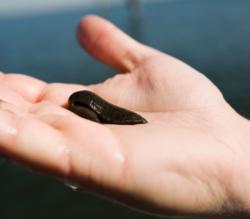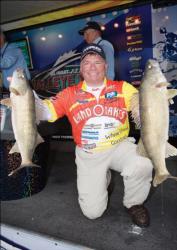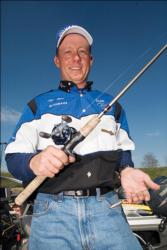Offshore rigging
Subtle adjustments to the classic Lindy Rig can turn finicky walleyes into willing biters

By middle to late summer on many natural lakes, there are no secrets. Stable and predictable patterns establish each open-water season. Main-lake structure and classic basin patterns are the basics for putting together a solid program together each summer on many of the most renowned walleye fisheries.
The trouble is that everybody knows this. Back in the day, there was a time when nobody else knew about a small hump or rock pile that was a mile from shore and basically stuck up in the middle of nowhere out of the lake basin. Everybody had their secret little honeyholes, and anglers had to work to find them again. Before GPS and specifically, detailed lake maps, finding the transitions, humps and bumps that concentrate walleyes in the middle of summer on lake basins took some effort. A little know how, lining up on distant shorelines that seemed mirage-like in the distance and an awful lot of zigzagging kept many spots pretty safe.
Today on almost any of the famous walleye factories, there are fewer and fewer spots that are actually secrets. The bottom line is that there are other anglers pulling fish off spots besides you. Over time, you can bet your favorite waypoints somehow find their way onto a lot of other GPS units. This is the reality anglers face today as equipment continues to improve. Come late July and August, fishing can seem difficult, even though the location for both fish and forage can seem predictable. The dead horse has been beaten. Anglers have been working some of these patterns for quite some time. Often, new or alternative patterns haven’t emerged. The only choice for many walleye anglers in this scenario is to bear down on what is available and try to get one more glass of water from the well. While you might have to look deep into the well at times, some Walmart FLW Walleye Tour pros like Eric Olson remind us that the well is never completely dry.
Like many anglers that work traditional mid-lake structure, mud flats and transition areas in the basins of natural lakes, Olson often prefers a simple Lindy Rig. Fact is, so does almost everybody else in some form or another. In fact, there are probably walleyes that see several Lindy Rigs pulled in front of them over the course of a summer. When conditions get tough, savvy anglers have long recognized the importance of using longer snells made with lighter monofilament. Tough walleyes can often be coaxed with good bait and a little finesse. More and more anglers like Olson are starting to confess, however, that there are many other details as well that can be fine-tuned to finesse walleyes from seemingly tough fishing situations. Some of these details can turn a hot, tedious day of swatting mayflies into the kind of day we envision when we pick up a travel brochure.
Despite the fact that we can’t talk to walleyes and walleyes aren’t capable of talking to us, Olson stressed the point that many anglers don’t listen to what the conditions are telling them. In Olson’s eyes, there are two major adjustments that usually have to take place each day when conditions get tough. The first adjustment is finding the right bait or presentation that actually triggers a walleye into striking. The second adjustment deals with finding the right combination of bait size, hook placement and amount of time to feed the fish to effectively hook up.
With all the different varieties of fishing line available today, a low-memory, limp monofilament line like Berkley XL remains the reigning king of snell material. Some anglers opt for fluorocarbon for some clear-water situations, but fluorocarbon has a tendency to sink. Olson often prefers standard 6-pound mono for the business end of most rigging but will sometimes go as light as 4-pound mono. When conditions get tough, hook good, lively bait lightly for optimum action and check the bait often. Olson ties most of his snells with either No. 6 or No. 8 premium snell hooks with a snell knot. Small hooks offer a livelier presentation and enable both minnows and leeches the ability to swim up off the bottom. The snell knot can’t be overlooked and offers better presentation when the hook can trail straight and also offers better hookups. Many walleye pros, Olson included, have a lot of confidence with colored hooks, and at times, a single bead is added for additional color.
Longer snells are often necessary when dealing with pressured or turned-off fish. The problem with snells that are more than 7 feet long is landing fish. Olson often ties most of his snells about 6 feet and ties the snell to a small ball-bearing swivel. He also usually pinches a small split shot onto the main line between the weight and the swivel so that snell length can be easily adjusted to a much longer length. The beauty of this rig is that the angler can reel the weight and split shot up to the rod tip and the split shot will slide down the line, enabling the angler to land the fish without dealing with the hassle of extremely long snells.
For feeling fish and bottom composition, no-stretch superlines like Berkley FireLine can be hard to beat for the main line. Olson often spools up with either 6- or 8-pound FireLine. On the main line itself, he slides on a quick-change clevice and ties on a small crankbait snap. The quick-change clevices are handy for swapping weights. Many anglers are using the traditional walking sinkers less and are opting for the Lindy NO-SNAGG Sinkers, which can be snapped into the quick-change clevices. The snells tied with a small barrel swivel can be snapped into the crankbait snap and snell length can be quickly adjusted by sliding the split shot up and down the main line. A big problem that can arise from using light line on the snells is line twist. Olson stressed high-quality barrel swivels with ball bearings are important to prevent line twist. Don’t skimp on the swivels.
All the right moves
The three most popular and arguably productive bait options come midsummer are leeches, crawlers and minnows, which are usually either fatheads or chubs. Regardless of what kind of bait being used, lower the snell into the water and drag the bait next to the boat before fishing. If the bait doesn’t squirm and look good next to the boat, it probably will not look so good in front of the fish. How and where you hook the bait can also really set your presentation apart, and the most successful riggers in difficult situations are often straying from tradition when hooking the bait.
Leeches are traditionally hooked through the back sucker. When the bite gets tedious, however, hooking the leech in the middle or nicking the leech through the back with a light No. 8 hook will enable it to swim harder and higher off the bottom. Traditionally, many anglers kept and stored leeches cold in coolers. Leech containers that store leeches in the livewell at warmer temperatures often make for more hyper leeches, however. Sort through the leeches until you find one that you can hardly hold in your hand. Hyper leeches catch more fish.
If water temperature is causing the leech to ball up on the hook, a little bit of Preparation H can be used to get it to unwind and swim hard. Fishing midlake structure is often a slow, vertical affair where you want the leech working hard on the end of the snell. You usually can’t fish an active leech very fast without twisting the snell and causing the leech to spin. If, however, you need to speed up to cover water, you can fish leeches faster by using a floating jighead instead of a plain hook and by hooking the leech through the tip of the nose and lightly stepping on it. The floating jighead will give the slightly squashed leech a wobble in the water, and the presentation won’t spin and twist at faster speeds.
Crawlers are often traditionally hooked through the nose. Olson often hooks the crawler about three segments back from the tip. Wacky rigging, or hooking the crawler through the middle, can give walleyes a different profile, and the crawler really squirms and comes to life in the water when hooked this way, especially with short starts and stops by either using the electric trolling motor or by moving the rod. Olson almost always pumps some air into the crawler as well. With either leeches or minnows, you seldom want the bait to spin but crawlers can be extremely effective with a little twist. Instead of running the hook straight through the crawler, knick the crawler about five segments back and make sure you run the hook through about three segments when you knick the crawler with the hook.
Another alternative is to hook the crawler on a floating jighead. This will cause the crawler to roll and spin through the water, which can be extremely effective for catching walleyes.
“Sometimes,” Olson explained, “for whatever reason, the fish will really show a preference for  crawlers if you can get them to spin some as they get pulled through the water. With crawlers, definitely experiment with running the bait straight and naturally but also try spinning or rolling.”
crawlers if you can get them to spin some as they get pulled through the water. With crawlers, definitely experiment with running the bait straight and naturally but also try spinning or rolling.”
During tough bites, Olson will also sometimes pinch the crawler off and just use half a crawler. Half-crawlers can’t be pumped with air and usually drag closer to the bottom, but there are times when Olson has found that the combination of the bait dragging the bottom and the increase of smell in the water can make a difference.
Fathead minnows and chubs can often be overlooked by anglers in the heat of summer, but both can shine during the most unlikely of times. By midsummer, however, male fatheads turn black and develop bumps on their heads. Olson often sorts through the fatheads to find the females he believes look and smell better to walleyes. Over the years, Olson has concluded that the male fatheads don’t work as well for bait.
Minnows are sometimes more difficult to keep alive on the hook than leeches or crawlers. Most anglers hook minnows through the lips. At extremely slow speeds, however, tail hooking the minnow or hooking the minnow upside down will often force it minnow to struggle hard. This struggle will sometimes trigger fish. The downside of hooking the minnow anywhere but the lips is that they often die faster.
Tough bites often dictate downsizing and finesse, but upsizing can often turn barely distinguishable hits into harder, more distinguishable bites. Large chubs are always an option and can turn the most lethargic walleye into a top-of-the-line predator. There is no substitute for wild red-tail chubs. Wild chubs struggle and work on the end of the snell like no other minnow. Many anglers often hook chubs just through the top lip and even run the hook a little ways through the bone on the forehead for optimum performance. With chubs, an angler can often tell when a walleye is approaching by how the chub acts. Chubs get pretty nervous in the proximity of walleyes and you can feel the struggle on your rod tip. Often, shorter snells are used when rigging chubs to keep the chub in front of fish. Snells that are too long enable the chub to swim out of the strike zone, so keep the chubs on a shorter leash.
Don’t be a drag
When probing classic structure and deep mud flats during the dog days of summer, Olson explained  that rigging often ends up being a slow and vertical presentation. The mistake Olson sees many anglers make at times with rigging is letting out too much line. There are times and situations where you actually want the sinker to drag, but often, especially on mud-bottom lakes like Mille Lacs, you want to find the bottom periodically and keep the weight slightly off the bottom. This offers a couple of advantages. First, the weight doesn’t stir up the mud bottom, and second, keeping the weight from bogging down in the bottom enables you to feel light bites much easier. There are other factors that come into play as well like boulders and rocks, which can sometimes be fished much more effectively if the weight isn’t dragging.
that rigging often ends up being a slow and vertical presentation. The mistake Olson sees many anglers make at times with rigging is letting out too much line. There are times and situations where you actually want the sinker to drag, but often, especially on mud-bottom lakes like Mille Lacs, you want to find the bottom periodically and keep the weight slightly off the bottom. This offers a couple of advantages. First, the weight doesn’t stir up the mud bottom, and second, keeping the weight from bogging down in the bottom enables you to feel light bites much easier. There are other factors that come into play as well like boulders and rocks, which can sometimes be fished much more effectively if the weight isn’t dragging.
Electronics also offer a few clues to refining the rig even further.
“There are times in the middle of summer when the bug hatches get so thick the bottom of the screen is solid, and I can’t even mark fish on the electronics. I have found that I usually catch more fish if I can get the bait above the bug hatch where fish can see and find the bait. This is one of the times when I will add a small float above the bait and fish the bait higher off the bottom,” Olson added.
Olson also incorporates a start-and-stop method of scouring structure. People often look for a magic depth and want to stay in that exact depth, but Olson prefers to work up and down the break. An electric trolling motor is used to give the boat short scoots up and down breaks and structure. Fish on the electronics will often cause him to stop momentarily, letting the bait work in front of fish. While there isn’t much speed involved, changes of speed are another tool Olson uses to trigger fish.
Come the hottest, flattest days of summer when many anglers swear that there isn’t a walleye left in the lake, some anglers just keep catching fish. A classic presentation on some classic summer locations can continue to put fish into the boat with a few refinements and adjustments. Paying attention to the details and adjusting throughout the day can possibly turn a tough bite upside down. Just remember that if whatever you are doing isn’t working, make adjustments until you find something that triggers fish. Some days, the smallest, seemingly slightest changes in how you present bait can mean the difference between catching fish and complaining with the masses at the boat ramp.
